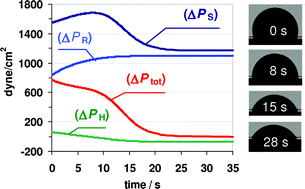Computation of transient flow rates in passive pumping micro-fluidic systems†
Abstract
Motion in micro-channels of passive flow micro-fluidic systems can be controlled by proper design and estimated by careful modeling. We report on methods to describe the flow rate as function of time in a passive pump driven micro-fluidic system. The model considers the surface energy present in small droplets, which prompts their shrinkage and induces flow. The droplet geometries are controlled by the micro-fluidic system geometry and hydrophilicity of the droplet channel contact area so that the chord of the droplet's cross section is restrained as the fluid is pumped. The model uses interfacial thermodynamics and the Hagen–Poiseuille equation for calculating the flow rate in micro-channels. Existing analyses consider the theoretical relationships among sample volume and induced flow rate, surface energy of the drops at the entrance and exit ports, and the resistance to flow. This model provides more specific information on the influence of the experimental conditions in computations of the flow rate. The model was validated in four sets of experiments. Passive pumps with 1.8 mm diameter, hydrophobic or hydrophilic entry ports, 5.0 or 10.0 mm channel length, and 2.5 or 3.3 mm diameter reservoir ports provided initial flow rates between 85 nL s−1 and 196 nL s−1.


 Please wait while we load your content...
Please wait while we load your content...